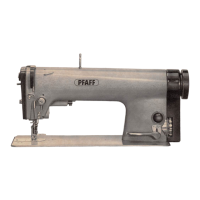8. Seize the bobbin case base by its center stud and tilt it out of the sewing hook, pulling
it
down
and
to
the
left.
9. Thoroughly clean the hook raceway and the bobbin case flange and remove all lint with
a
pointed
wooden
instrument,
never
with
a
screwdriver.
10.
Before you replace the bobbin
case
base, it is best to
screw
on bobbin
case
position
finger bracket A. When replacing the bobbin case base, make sure finger h on bracket A
enters
slot
I in
the
rim of
the
bobbin
case
base.
Also
check
to
see
that
there
is a
clearance
about
V64", or 0.5 mm, wide between the tip of position finger h and the bottom of slot i.
11.
Replace
hook
gib
d
and
turn
in
set
screws
el,
e2
and
e3.
12. Swing the mechanical opener back to its original position and adjust as instructed in
Chapter 24. This tricky job
should
be performed by your
maintenance
man.
23.
The
Mechanical
Opener
All models of the Pfaff 467 are regularly fitted with a positive mechanical opener. The double-
revolution rotary hook of the Pfaff 467 enters the needle thread loop at every other revolution
and
passes
it
around
the
stationary
bobbin
case.
On
machines
having
no
mechanical
opener,
the
needle
thread
has
to
turn
the
bobbin
case
slightly in
oder
to make an
opening
through
which
it can pass.
The friction between hook raceway and bobbin case flange and the attendant pressure of the
position finger against the wall of the position slot increase in proportion to the sewing
speed
so that the needle thread has to overcome a stronger resistance when opening a clearance gap.
On machines fitted with mechanical opener, the opener finger slightly rotates the bobbin case
at
the
right
time
and
contrary
to
the
direction
of
sewing
hook
rotation
so
that
the
needle
thread
can
pass
freely
between
position
finger
and
position
slot.
This
ensures
that
the
tension
on
the
needle thread will remain
the
same, regardless of
the
sewing
speed
because
it is not
exposed
to additional stress, particularly at higher
sewing
speeds.
Since
the
danger
of thread
breaking has been largely eliminated, it is possible to use threads of a lower tensile strength
even
for
high-speed
sewing
operations.
Another advantage afforded by the mechanical opener is that even lightweight fabrics can be
sewn
at full
speed
while
the
machine
is
being
run in, or
after
a
new
hook
has
been
inserted.
32

